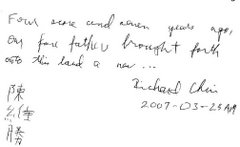In this post, I thought I'd describe my medical symptoms and exercise regimen. In general, my goal for improvement focuses less on strength but more on balance and coordination. Today's entry is of interest for those who wish to learn more about about these aspects of my condition.
The most significant symptom is that my balance and upright walking have progressively worsened. I can and do use a walker on occasion. However, when at home, traveling and going outside in the evenings I mostly use a wheelchair. The second most severe symptom is fatigue. A long day is just beyond my ability, and I need a midday refresher nap to restore my energy for the latter portion of the day. Multi-tasking is out of the question now.
MJD has a significant impact on matters relating to the senses and speech. I slur my speech as I become more tired. I'll also choke on certain foods - spicy, hot, especially flaky in particular - if I'm not careful. I also experience double vision. I have prisms in my eyeglasses that help with distance viewing such as the TV. Age complicates reading small fine print in dim light, but I can still manage without glasses. I also have horizontal nystagmus (rapid, involuntary oscillation of the eyes). This is one major reason why I no longer drive.
I am now more sensitive to temperature extremes. I tolerate the cold less well than heat, which is why I prefer traveling in summer over winter. I also have poorer fine motor skills. My handwriting was not that great to begin with, but it is clearly worse now. I often write in caps to improve legibility. I do have more uncoordinated physical movements now; I'll avoid filling a glass of liquid too full, and I can't throw a ball anymore.
I suffer from neuropathy of the feet, which I interpret as a loss of sensation. I know my feet are there, and I can feel obvious sensations and movements, but I'm losing touch of the finer senses. I also experience infrequent cramping of the hands and feet. This most frequently occurs when gripping with the toes or fingers. I hope to avoid starving in China when using chopsticks!
When sleeping, I exhibit myoclonus - jerking, involuntary movements of the arms and legs. I also occasionally have night terrors - acting out dreams. Rest assured, though, that I experience no pain (unless I fall!) and do not use any regular painkillers.
To help minimize the effect of these symptoms, I make an effort to exercise during the week. Typically I go twice a week to the local YMCA for a session on the exercise bike and for strength related exercises. I also do Pilates, a form of exercise that emphasizes core upper body (trunk) stability, with my wife once a week. On other days I'll spend time on our home exercise bike. I try to stick to "balance neutral" exercises. The exercise bike I use at home and at the YMCA is a "recumbent" one where the rider adopts more of a leaning position rather than sitting upright. In the past I had tried aqua therapy, but I eventually stopped because:
• It was too hard to get to the facility (though I may try again at another nearby facility)
• The logistics of getting between the pool and the locker area seemed to be more and more hazardous as my mobility degraded
• I was losing weight, which I attributed to too much energy expended on maintaining bodily warmth despite the fact that the pool was indoors and heated
The goals of this exercise regimen is to avoid muscle atrophy and injury by disuse.
Saturday, March 10, 2007
Thursday, March 8, 2007
Some thoughts on the medical treatment for ataxia in the U.S.
I have been seeing a local neurologist for years. He diagnosed my ataxia and completed the disability paperwork. He is very competent and compassionate but I am the only ataxia patient in his practice. That's one of the down sides of ataxia; it is so relatively rare that even specialists have hardly ever come across it. When it came to symptomatic treatment, I mostly drew blanks. Conversely, I have started to see Dr. Susan Perlman of UCLA late last year. In contrast, she is not a stranger to ataxia. Aside from being an acknowledged expert in the field, she has literally seen hundreds of patients with ataxia in her practice. She recommended a slew of medications and supplements that addressed my various symptoms ranging from swallowing and choking, slurred speech, fatigue and balance. I have experienced noticeable improvements in all of these areas since.
We just returned from a visit last week to see Dr. Perlman - for a "before" China visit. Within a month of returning, the plan is an "after" China visit. Dr. Perlman has been very interested in the goings on in China. She also described what might be reasonable goals for me after the stem cell treatment. Specifically, I would want to look for an improvement in upright standing/walking as well as an improvement in the neuropathy afflicting my feet ( a loss of peripheral sensation). I also suffer from horizontal nystagmus and double vision. However, I do not expect it to improve enough to drive again (which I stopped 1.5 years ago).
For ataxia, it is unlikely that stem cell treatment alone will be a permanent cure since the root cause of the disease isn't really addressed. The solution is the ability to alter the genetics of the afflicted. I like to think that is the work of Nobel prizes (one of which was recently awarded to Dr. Roger Kornberg for his work on genetic transcription) and a lot of subsequent clinical follow-up. The downside ... there is little attention for such a rare disease like ataxia. The upside ... ataxia shares many of the same traits and treatments as Huntington's and Parkinson's Diseases which do get more attention.
We just returned from a visit last week to see Dr. Perlman - for a "before" China visit. Within a month of returning, the plan is an "after" China visit. Dr. Perlman has been very interested in the goings on in China. She also described what might be reasonable goals for me after the stem cell treatment. Specifically, I would want to look for an improvement in upright standing/walking as well as an improvement in the neuropathy afflicting my feet ( a loss of peripheral sensation). I also suffer from horizontal nystagmus and double vision. However, I do not expect it to improve enough to drive again (which I stopped 1.5 years ago).
For ataxia, it is unlikely that stem cell treatment alone will be a permanent cure since the root cause of the disease isn't really addressed. The solution is the ability to alter the genetics of the afflicted. I like to think that is the work of Nobel prizes (one of which was recently awarded to Dr. Roger Kornberg for his work on genetic transcription) and a lot of subsequent clinical follow-up. The downside ... there is little attention for such a rare disease like ataxia. The upside ... ataxia shares many of the same traits and treatments as Huntington's and Parkinson's Diseases which do get more attention.
Wednesday, March 7, 2007
A brief introduction
For those who don't know me, my name is Richard Chin. I'm born and raised in the USA. Both my parents were immigrants from Canton, China (just a few hours north of Hong Kong and Shenzhen). I'm age 48 and for the past 10 to 15 years, I've shown signs of the ataxia I inherited from my dad who passed away about 19 years ago. Due to this disease, Spino Cerebellar Ataxia 3 (SCA3), I stopped working about 4 years ago . I was an engineer by trade. I am married with one daughter. My wife, Lily, is born and raised in Hong Kong. Our daughter, Andrea, is a college student in Los Angeles. We live in the San Francisco bay area near "Silicon Valley".
What is SCA3? Also known as Machado Joseph's Disease, it is one of the inherited forms (i.e. genetic) of a movement disorder. The word ataxia means without order. Ataxic symptoms may include slurred speech, uncoordinated physical movements, imbalance, nystagmus (rapid involuntary eye movement), etc. There are over a dozen subclasses of spinocerebellar ataxia (SCA). Medically, it is a neurological disease affecting the cerebellar part of the brain. How prevalent is the disease? Within the USA, SCA is listed in the National Organization of Rare Diseases (NORD). At present, there is no cure to the disease. However, there are not only palliative drugs but also research being conducted to finding the cure.
I am slated for stem cell "therapy" at Nanshan Hospital in Shenzhen, China. My wife and I will travel to Shenzhen for our 30 day stay beginning Monday, March 19. Following the footsteps of several MJD'ers who underwent treatment at Nanshan, I am planning on five stem cell injections, 4 via lumbar puncture and one by IV.
I've wondered about the nature of this blog since it is likely to be read by a wide spectrum of people from close family and friends to total strangers who happen to see it on the Beike Stem Cells website. I've decided to make it a log of the day-to-day events leading up to our trip and our experiences while in China, rather than an intimate diary or a technical research paper.
What is SCA3? Also known as Machado Joseph's Disease, it is one of the inherited forms (i.e. genetic) of a movement disorder. The word ataxia means without order. Ataxic symptoms may include slurred speech, uncoordinated physical movements, imbalance, nystagmus (rapid involuntary eye movement), etc. There are over a dozen subclasses of spinocerebellar ataxia (SCA). Medically, it is a neurological disease affecting the cerebellar part of the brain. How prevalent is the disease? Within the USA, SCA is listed in the National Organization of Rare Diseases (NORD). At present, there is no cure to the disease. However, there are not only palliative drugs but also research being conducted to finding the cure.
I am slated for stem cell "therapy" at Nanshan Hospital in Shenzhen, China. My wife and I will travel to Shenzhen for our 30 day stay beginning Monday, March 19. Following the footsteps of several MJD'ers who underwent treatment at Nanshan, I am planning on five stem cell injections, 4 via lumbar puncture and one by IV.
I've wondered about the nature of this blog since it is likely to be read by a wide spectrum of people from close family and friends to total strangers who happen to see it on the Beike Stem Cells website. I've decided to make it a log of the day-to-day events leading up to our trip and our experiences while in China, rather than an intimate diary or a technical research paper.
Subscribe to:
Comments (Atom)


